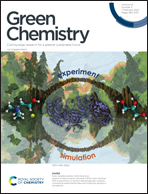Efficient glycolysis of PET catalyzed by a metal-free phosphazene base: the important role of EG−Electronic supplementary information (ESI) available. See DOI: 10.1039/d1gc03885k
Abstract
Developing efficient metal-free catalyst for the glycolysis of waste poly(ethylene terephthalate) (PET) with ethylene glycol (EG) has attracted increasing attention due to the demanding requirement for high-quality monomer used in regeneration. Herein, a new kind of efficient metal-free catalyst phosphazene base (t-BuP2) was developed through the combination of theoretical prediction and experimental verification approaches, which could achieve 100% conversion of PET and obtain BHET yield (92.7%) comparable to metal-based catalysts. The high efficiency of t-BuP2 comes from the facile generation of EG−, which has a strong ability to break the PET chain through a nucleophilic attack on the carbonyl group. t-BuP2 was selected as the catalyst based on the theoretical evaluation of the proton abstract ability of various bases through natural bond orbital analysis and reaction energy calculations, which could deprotonate EG barrierlessly to produce EG−. Next, the nucleophilic attack of EG− on the carbon atom of the carbonyl group in PET occurs, which greatly weakens the strong C–O bond on the PET chain. Then, the C–O bond was cleaved (rate-determining step) with the Gibbs activation energy and Gibbs reaction energy of 20.2 and −3.8 kcal mol−1, respectively, which was followed by the glycolysis step to produce BHET. Furthermore, t-BuP2 was found to have high regeneration performance, which could be recycled at least seven times without an apparent decrease in activity.



 Please wait while we load your content...
Please wait while we load your content...